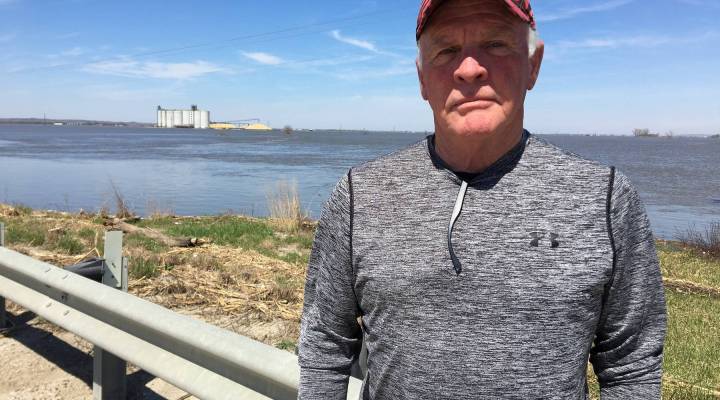
Bad weather and trade complicate planting for Midwest farmers
Bad weather and trade complicate planting for Midwest farmers

Clothes and bottled water are piled high in the backseat of Richard Oswald’s pickup, among the few things he could carry out of his flooded home that sits along the Missouri River.
It’s been this way since mid-March when a “bomb cyclone” hit the Midwest, flooding a million acres of farmland from the Dakotas south to Missouri. Oswald, a corn and soybean farmer near Langdon, Missouri, is not working in his fields, as he typically would be in the spring, but instead viewing the flooded acres from a highway, near a truck stop named “Trail’s End.”
“This is a field that we farm, right next to the truck stop,” Oswald said. “You can see that there’s still water in it and the water’s actually creeping back in now. So it’s getting deeper again, coming towards us.”
Spring planting is just getting started on farms across the Midwest, but lots of extreme flooding from snow and rain has slowed things down. Add international trade problems, and farmers are facing some difficult decisions.
“A lot of farmers are still debating whether or not they should try to plant a crop this year,” Oswald said, “but we don’t really have that option because there’s still two, to three, to five feet of water on top of these fields.”
One farmer is using this airboat to get to his fields near Langdon, Missouri, where flooding from a “bomb cyclone” in mid-March caused extensive flooding from the Dakotas south to Missouri.
U.S. highway 136 near Rock Port, Missouri, is blocked by a barricade because flood waters are covering the pavement. Blackened corn stalks line the road, along with tons of debris like tree trunks, propane tanks and farm equipment, which all washed down in the flood. A grain elevator in the distance looks like an island – 2 million bushels of corn and a million bushels of soybeans are rotting in the water.
While a million acres of lost farmland is not insignificant, said Todd Hubbs, an assistant professor of agricultural commodity markets at the University of Illinois, a recent U.S. Department of Agriculture survey reported that more than 315 million acres will be planted across the U.S. this year. More importantly, Hubbs said, the wet spring is making for late planting, which could affect yields beyond the flooded areas.
“All in all, the weather that caused the flooding has got the ground in the Corn Belt saturated,” Hubbs said.
Oswald’s great-great grandfather settled the family here. He’s seen flooding before – 2011 was particularly bad. But he says this is the worst he’s seen in his 69 years. He lost four grain bins containing two-thirds of last year’s crop – a loss not covered by insurance.
“That was probably going to be my net income for the year,” he said. “So I know I’m not going to make any money.”

An aerial shot of Richard Oswald’s farm near Langdon, Missouri, on March 22, just days after a “bomb cyclone” hit the Midwest, causing extensive flooding.
Oswald said he that out of 2,000 acres he farms, he will only be able to plant about 500 acres that are on a hill east of the worst flooding. The decision on what to plant is difficult, Oswald said, because there is a huge surplus of soybeans, thanks to the trade war with China.
“The problem is, most farmers throughout the Corn Belt make a decision,” he said, “and they make a decision whether to plant more corn or more soybeans. Well, if soybean prices are low, they’re going to plant more corn. What happens then? Well, the next year you got too much corn.”
Oswald said some people near the Trail’s End truck stop are joking that it should be called “water’s end,” because the flooded fields are so close. He’s still hoping to get federal aid for his home, where he was born. He plans to build on higher ground.
There’s a lot happening in the world. Through it all, Marketplace is here for you.
You rely on Marketplace to break down the world’s events and tell you how it affects you in a fact-based, approachable way. We rely on your financial support to keep making that possible.
Your donation today powers the independent journalism that you rely on. For just $5/month, you can help sustain Marketplace so we can keep reporting on the things that matter to you.


















